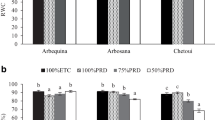Abstract
Tunisia’s olive resources are estimated at over 83 million of olive trees, grown on 1.83 million ha. Despite the immense potential for olive production, Tunisia is known as an underprivileged country in water resource and water scarcity is evident in certain regions. In the long-term, this situation could become more and more exacerbated, considering the increased risk of aridity. Plants grown in these regions are often exposed to a long period of drought and harsh environmental conditions, which affects plant growth and, hence, agricultural development. In order to increase productivity of olive trees the intensification of the olive tree sector in Tunisia is a necessity. The irrigated olive orchards in Tunisia cover about 75000 ha in 2016.
Access this chapter
Tax calculation will be finalised at checkout
Purchases are for personal use only
Similar content being viewed by others
References
Chartzoulakis K. Salinity and olive: Growth, salt tolerance, photosynthesis and yield. Agric Water Manage. 2005;78:108–21.
Chartzoulakis K, Loupassaki M, Bertaki M, Androulakis I. Effects of NaCl salinity on growth, ion content and CO2 assimilation rate of six olive cultivars. Sci Hortic. 2002;96:235–47.
Gucci R, Lombardini L, Tattini M. Analysis of water relations in leaves of two olive (Olea europaea) cultivars differing in tolerance to salinity. Tree Physiol. 1997;17:13–21.
Vigo C, Therios IN, Bosabalidis AM. Plant growth, nutrient concentration, and leaf anatomy of olive plants irrigated with diluted seawater. J Plant Nutr. 2005;28:1001–21.
Author information
Authors and Affiliations
Corresponding author
Editor information
Editors and Affiliations
Rights and permissions
Copyright information
© 2018 Springer International Publishing AG
About this paper
Cite this paper
Boussadia, O., Zaabar, R., Braham, M. (2018). Ecophysiological, Nutritive and Growth Responses of Two Olive Tree Cultivars (Olea Europaea L. ‘Chemlali’ and ‘Koroneiki’) Under Salt Stress. In: Kallel, A., Ksibi, M., Ben Dhia, H., Khélifi, N. (eds) Recent Advances in Environmental Science from the Euro-Mediterranean and Surrounding Regions. EMCEI 2017. Advances in Science, Technology & Innovation. Springer, Cham. https://doi.org/10.1007/978-3-319-70548-4_367
Download citation
DOI: https://doi.org/10.1007/978-3-319-70548-4_367
Publisher Name: Springer, Cham
Print ISBN: 978-3-319-70547-7
Online ISBN: 978-3-319-70548-4
eBook Packages: Earth and Environmental ScienceEarth and Environmental Science (R0)




